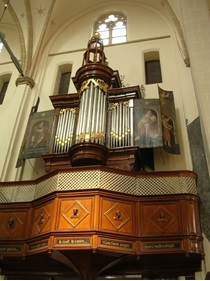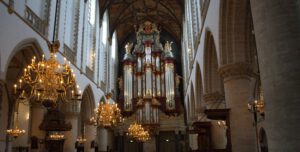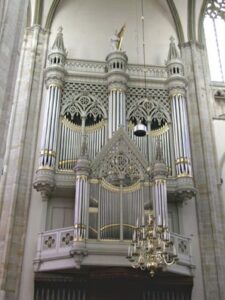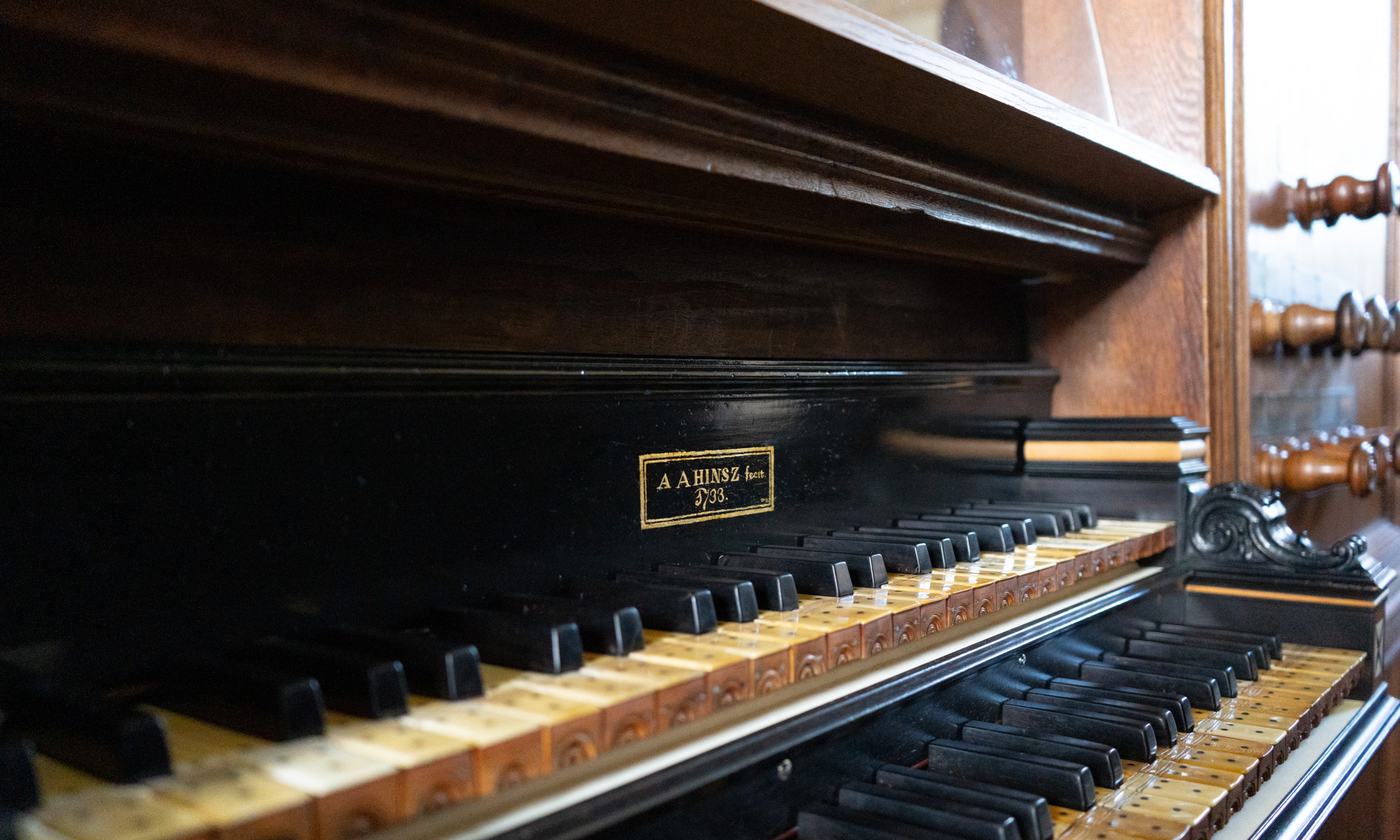The appearance of an organ is not only determined by the organ builder. In most cases it is the result of the collaboration between organ-builder, architect and visual artists. Many splendid examples of this collaboration are to be found throughout the Netherlands.
In the 15th century larger organs were almost always placed on the northern wall of the nave, whereas smaller organs were “fixed” high on the church wall like swallows’ nests. Fascinating to look at, but often very difficult to reach their instrument was to walk through the gutter.

In the earliest period larger organs mostly had a borstwerk (breastwork) and a hoofdwerk (great), while in the 16th century the rugwerk (positive) and separate pedal-towers made their appearance.
In the Roman Catholic worship organists usually played a mix of secular and ecclesiastical music on their richly ornamented instruments. Therefore it comes as no surprise that during the reformation in the northern Netherlands not only religious artefacts, but also pipe organs were destroyed. Smaller instruments, which were placed in the proximity of the altar, were easy victims. Some larger organs, which were not so easy to reach, survived destruction, most of which took place during the iconoclasm of 1566.
This brought the flourishing organ-building craft to a halt. Most organ-builders moved to surrounding countries, were the reformation has less impact. In the drastically changed protestant worship there was no place for the organ. Congregational singing of the mainly newly introduced psalms and hymns was unaccompanied, certainly not very ‘refined’ in sound. In cities where organs survived the iconoclasm the instruments were used only during the week for secular organ recitals, organised by the city-councils, who since the reformation owned most instruments.
For some years the organ was used at the beginning and end of the protestant service only, but after many difficulties and lengthy discussions it was gradually accepted that psalms and hymns accompanied by the organ greatly improved congregational singing. The existing instruments were not powerful enough and organ-builders returned to the Netherlands to either rebuild or enlarge existing instruments with more powerful stops or build completely new instruments, designed specifically for accompanying congregational singing. New stops like the Cornet or Sesquialter were introduced; these compound stops facilitated a powerful, clear and pronounced melody-line. New technical inventions like couplers made it possible to combine the stops of the different departments of the organ, resulting in an increased volume of sound. In most cases the stops of the hoofdwerk (great) were coupled to the Pedal Organ, but in some larger instruments the Pedal Organ was provided with several independent stops.
The enormous prosperity of the Netherlands as a trading country made it possible to build the large and beautiful city-organs designed by city-architects in collaboration with organ builders and visual artists like painters and sculptors. In the second half of the 17th century the city-organ reached its peak. Monumental instruments with beautifully carved and gilded ornaments were build, sometimes provided with painted wooden shutters, which were closed to protect the organ when it was not used. The prosperity led to a certain competition between cities, all wanted to own the best, the largest, most modern and most richly decorated instrument. New techniques quickly developed and foreign influences were adopted. German organ builders like Schnitger, Hinsz and Müller were introduced and build new instruments that are now known as the best examples of “Dutch” organ building.
In the Netherlands the North German school of organ building had the greatest influence, with a strong emphasis on clarity and brilliance (many mixtures and mutation stops) and a clear visibility in the façade of the different departments of the organ. In instruments based on the southern (French) school of organ building the reeds and cornets were more important and the different departments were not necessarily visible in the façade. Good examples of both schools are the instruments of the St. Bavo in Haarlem (1738, German influence) and the St. Jan in Gouda (1732, French/southern influence).

Bavokerk, Haarlem
In the 18th century new influences found their way to the organ. Tone colours were copied from the expanding and developing orchestras of that period. Organ builders developed stops that imitated the sounds of the orchestra, resulting in stops with names like Flute Travers, Oboe and Violon. The stops made it possible to play ‘effect’ music, all things from nature like storms, thunder and birdsong were imitated on the organ. During this period effect was more important than musical content. The introduction of equal temperament made it possible to play in all keys. New inventions like the enclosure of complete departments of the organ in a wooden swell box, closed on all sides except for the front in which movable shutters were placed, made a gradual crescendo and decrescendo possible without the change of stops.

In the 19th century the swell box became a essential part of the organ, not only necessary for playing transcriptions of orchestral music, but also for music especially written for the organ. The need during the Romantic period for larger organs led to the development of new techniques. Larger organs required more complicated mechanisms, which demanded much physical strength from the organist. Organ builders were looking for new ways to overcome the physical strength needed to play the complicated and extremely heavy mechanical action in the organ. First the pneumatic action was developed, a system by which the pallets under the pipes were opened by wind pressure. Later a system followed in which electromagnets were used to make the pipes play. Playing an organ with either pneumatic or electric action was as easy as playing the piano, no mater how many stops were drawn. Both systems made it possible to ‘detach’ the console from wind chests and pipes. Especially by using electric action it was possible to place departments of the organ in all parts of the building, the only limitation being the length of the electrical cable. The all-over industrialization of the late 19th century and first half of the 20th century also had its impact on organ building. Fierce competition between companies led to the use of cheaper and inferior quality materials. Some “organ builders” ordered complete instruments from cheap German supply factories that were specialised in the production of pipe-organ parts. One of the most cost saving developments was the introduction of the so-called unit system, in which one rank of pipes could be used for several stops. Through simple electrical switching a normal rank of 56 pipes extended one octave downwards (12 pipes) and one octave upwards (12 pipes), could provide three stops.
Three independent stops would normally required 168 pipes, the use of the unit system brought this number back to only 80 pipes! Needless to say that by using this system the individuality between stops was lost, all three stops sounded exactly the same. Although the unit system was used successfully in the theatre or cinema organ, its use in classical organs was much criticized. Since 1900 the loss of the “true” organ led to much discussion and reflection. New movements led to a return in the second half of the 20th century to the craft of organ building. Mechanical or tracker actions and specifications based on historical principles were re-introduced. Especially during the last decades of the 20th century Dutch organ builders distinguished themselves worldwide by building high quality, classically oriented pipe organs, which can be found all over the world, and in the Netherlands.
